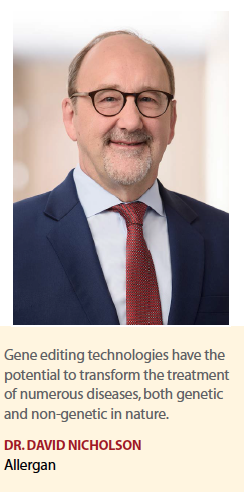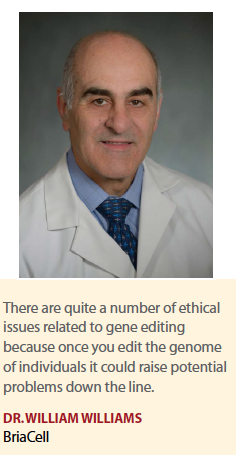New technologies for gene editing have created excitement about the potential for cures for diseases, as well as debates around ethics and regulatory oversight that are sure to dominate this field of science for years to come.
CRISPR-Cas9, the newest gene-editing tool, is getting a lot of attention. It uses a protein-RNA complex that has been designed to recognize a particular DNA sequence. It enables selective editing of defective genes and has the potential to allow safer, more precise gene modification.
 CRISPR-Cas9 is tool modified from a bacterial immune system and is composed of two basic parts: the Cas9 protein, which acts like the wrench, and the specific RNA guides, CRISPRs, which act as the set of different socket heads. These guides direct the Cas9 protein to the correct gene, or area on the DNA strand, that controls a particular trait. The modifiable RNA sequence guides the enzyme directly to the desired gene, resulting in selective activation, repression, deletion, or modification of that gene.
CRISPR-Cas9 is tool modified from a bacterial immune system and is composed of two basic parts: the Cas9 protein, which acts like the wrench, and the specific RNA guides, CRISPRs, which act as the set of different socket heads. These guides direct the Cas9 protein to the correct gene, or area on the DNA strand, that controls a particular trait. The modifiable RNA sequence guides the enzyme directly to the desired gene, resulting in selective activation, repression, deletion, or modification of that gene.
“Gene editing technologies have the potential to transform the treatment of numerous diseases, both genetic and non-genetic in nature," says Allergan’s Chief R&D Officer David Nicholson, Ph.D. “Having the power to permanently modify genes gives researchers a critical new tool as they develop revolutionary treatments."
Allergan is working to deliver CRISPR genome editing treatments for eye disease in a partnership with Editas Medicine. This alliance includes Editas’ lead program, which is being developed for the potential treatment of LCA10, a rare, inherited retinal degenerative disease that appears in childhood and leads to blindness.
Researchers have only begun to tap into the potential that CRISPR-Cas9 promises. Consequently, the genome editing market, of which CRISPR-Cas9 already accounts for more than half, is poised to expand rapidly over the coming years. By 2021, the market for products to support CRISPR-Cas9 research will reach $3.61 billion in annual revenue, according to a recent BioInformatics report.
The growth of the market can be largely attributed to an improved funding landscape, BioInformatics researchers say. The National Institutes of Health and other organizations have increased their funding for CRISPR-focused research. Federal funding for CRISPR-related research has radically increased, with NIH funding for the field jumping from $5.1 million in FY11 to $603 million in FY16. On the commercial side, contract research organizations have increased their use of the technique to genetically engineer model animals and cell lines for research purposes.
But the technology has also led to concerns about the ethics of editing our genes. Two groups of scientists stirred up some controversy recently when they announced they had each successfully altered human embryos. In August, the first group of researchers from Oregon reported in Nature that they had successfully altered human embryos to correct for a genetic mutation that often leads to heart failure. And in September, a separate team in China published in Protein & Cell that it created cloned embryos with a genetic mutation for a potentially fatal blood disorder and then corrected the gene that leads to this disorder.
Articles and blogs began questioning whether there needs to be stricter regulations for CRISPR and gene editing techniques.
There are quite a number of ethical issues because once you can start to edit the genome of individuals it could raise potential problems down the line, says William Williams, M.D., CEO of BriaCell Therapeutics.
“Already, people are selecting the sex of their children based on prenatal testing and then eliminating those embryos that don’t fit what they want," he says “This raises a host of ethical issues, and CRISPR and in vitro fertilization may take this to a whole another level."
Dr. Williams points out that BriaCell is not using gene editing technology in its research. The company is conducting Phase I/II trials of BriaVax, a whole-cell breast cancer vaccine genetically engineered to release granulocyte macrophage colony-stimulating factor, a substance that activates the immune system.
Arthur Caplan, Ph.D., a professor of bioethics at New York University’s Langone Medical Center and founding director of NYULMC’s division of medical ethics, says he isn’t worried about an eugenic dystopia.
 “Even though we see papers published such as the one out of Oregon, it isn’t clear what happened," he says. “Researchers tried to edit in a gene to correct the genetic defect in a human embryo but it is not clear what else happened."
“Even though we see papers published such as the one out of Oregon, it isn’t clear what happened," he says. “Researchers tried to edit in a gene to correct the genetic defect in a human embryo but it is not clear what else happened."
While there is a lot of talk about using gene editing to cure diseases, we are a long way from the starting line, Mr. Caplan says.
He adds that the concerns about safety are not overblown. Dr. Caplan says scientists don’t know enough about the process of gene editing or even if different areas of the genome can be edited with the same efficiency and accuracy.
“We still have concerns about off-target mutations, which we are seeing in some mice models," he says. “And we are not even sure what is the best technique."
Regulations and Oversight
Since December 2015, Congress has included provisions in annual federal appropriations laws that prohibit the FDA from accepting applications for clinical research using mitochondrial replacement technology (or MRT).
Therefore, clinical research using MRT in humans cannot legally proceed in the United States. The annual appropriations law prohibits the FDA from acknowledging applications for an exemption for investigational use of a drug or biological product in research in which a human embryo is intentionally created or modified to include a heritable genetic modification.
Dr. Caplan says new regulations would be a mistake, and he feels the industry needs to do a better job of self-policing.
“For example, companies need to set out rules for when this technique should be tried clinically and what evidence would be sufficient," he says. “They should demand a registry to track everything — both short- and long-term, even over generations, as a condition of clinical use."
For embryonic stem cells, he says the industry should set out its own rules about where embryos come from.
“Companies don’t need to wait for the government," Dr. Caplan says. “And journal editors should take an active role in restricting publishing findings that don’t adhere to the guidelines that professional societies and groups have laid out."
Dr. Caplan says there are secondary issues that people aren’t talking about: who owns the technology, which is a patent problem that is going to get in the way of this type of research.
“We can just look at the fights over CRISPR technology," he says. “Already we’ve seen that tools and technique patents can really show off problems of access."(PV)
~~~~~~~~~~~~~~~~~~~~~~~~~
Genome editing: Bioethics shows the way
 Arthur Caplan, Ph.D.
Arthur Caplan, Ph.D.
Professor of Bioethics,
New York University
Langone Medical Center
Carolyn Neuhaus
Research Scholar,
Hastings Center
When some scientists hear the word “bioethics," they break out in intellectual hives. They shouldn’t. Bioethics has done far more good than harm in advancing medical research: creating a framework for responsible research with animals, involving vulnerable and marginalized persons in clinical research, and providing a moral foundation for transplant research. Perhaps the same cannot be said for lawyers, regulators, politicians, or theologians, but they do not represent bioethics.
Bioethicists think about the ethical aspects of biomedical research and its consequences. The best bioethics work sparks conversations inside research communities and then moves them into the public sphere. Sometimes bioethics research exposes unethical practices in science and medicine, such as historical abuses of human subjects in the Tuskegee syphilis experiments. Other times, bioethicists think prospectively about the ethics of emerging technologies. Workable solutions to past and current ethical concerns often emerge, despite disagreements. Good bioethics is about enabling science to move forward rather than raising simpleminded in-principle objections, vilifying researchers, invoking arguments against playing the divinity, or setting arbitrary limits. The field is needed to advance cutting-edge biomedical research in domains in which the benefits to be had are enormous, such as genome editing, but ethical concerns persist.
For example, the discovery of recombinant DNA (rDNA) in the 1970s ignited discussions around the ethics of eugenics and using the technology to intentionally modify the human genome to create designer babies. The fact that these terms require no clarifying definitions means that bioethicists have largely been successful at promoting public discourse about what it would mean to design humans. We haven’t achieved consensus over whether we should select the traits of our offspring, but an international conversation is ongoing about the issue.
Since the initial ethical discussions surrounding rDNA, scientists have mapped the human genome, rolled out gene therapies, and developed improved genome-editing techniques. That’s bioethical success: cautiously moving forward while staying informed about the ethical issues and remaining sensitive to a wide diversity of perspectives.
Other questions raised by advances in genetics have gotten fewer journal pages but are equally important to advancing science. Consider genome editing in nonhuman organisms. While ethical debate tends to focus on human applications, issues around the use of genome editing in animals require attention and may well help clarify the limits and boundaries of human use.
Genome editing makes possible large-scale production of disease models in large animals, such as pigs, dogs, and nonhuman primates.
While the creation of model organisms sometimes reveals new insights into the genetic underpinnings of disease and facilitates characterization of genetic pathways, it also contributes to animal suffering, perpetuates the use of animals in research, and challenges fundamental assumptions about the moral status of animals. Yet, research will proceed if suffering is minimized, utility and safety established, and boundaries put on what can be done to animals in the pursuit of knowledge (as opposed to the pursuit of amusement).
Or, consider the use of genome editing to eliminate pest populations and disease vectors in the wild, such as invasive species, mosquitoes, or mice. Such applications promise to eliminate some of the globe’s biggest public health threats but could also disrupt ecosystems. Public pushback against genetically modified food does not bode well for the prospects of widespread use of either genetically modified insects or animals. But, even despite a fraught history, the future of genetic engineering to fight blights, fungi, and insect pests is not doomed.
A prudent path forward for ethics research on gene drives and genetic solutions to environmental challenges will create forums for inclusive public discussions and integrate divergent perspectives into ethics literature and policy. Proposals for how to do this through community engagement can be found in Massachusetts and the Florida Keys.
Consider the rapid development of gene therapies, often combined with stem cell modifications, to combat cancer. When are gene therapies ready for first-in-human use? The death of five patients in a 2016 clinical trial of chimeric antigen receptor T cell (CAR-T) therapy brings this ethical question into sharp focus. It is not settled by patients’ consent. Many terminally ill people and their families desperately cling to the hope that a novel, experimental drug provides. They value fighting to stay alive more than safety. On the other hand, regulators often prefer a cautious approach to first-in-human trials. Whether a drug is ready for first-in-human use depends on whether you ask a dying patient, a treating clinician, a drug company’s CEO, or a Food and Drug Administration official. Debating what role animal data ought to play in these decisions remains key to their resolution.
The questions that consume ethicists are of real-world and real-time importance to scientific researchers and lay people alike. It’s not only (and not even usually) Ph.D.s in philosophy who think about whether it’s okay to use animals in research, how to study gene drives in the wild, or when to move from animals to first-in-human use. Looking at those practices, coming up with a vocabulary for talking about the values behind them, and having a dialogue about them not just in ethics journals but also in the media, in classrooms, at the watercooler, and elsewhere are essential for advancing science without engendering misguided or ill-informed pushback. Genome editing and other biomedical and scientific innovations ought not to founder simply because a distrustful public has been shut out of discussions, because scientists failed to make an ethical case for moving forward, or because bioethicists were denied the opportunity to create reasonable proposals that accommodate both concern and enthusiasm.
Bioethics pushes scientists to acknowledge that they operate not within a vacuum but within a society in which diverse perspectives and values must be engaged.
Bioethicists give voice to those divergent perspectives and provide a framework to facilitate informed and inclusive discussions that spur progress, rather than stall it. In an era in which so many pressing challenges will depend on the innovations of science, from emerging infectious diseases to food security, the need for progress that’s both ethical and accountable has never been greater.

















